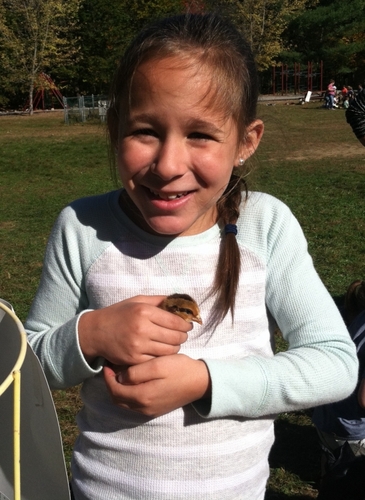NEWFANE — On a recent sunny Friday, in the field behind NewBrook Elementary School, every 15 minutes a cowbell clunked out its hollow ring.
That sound told students at the school's Farm and Field Day it was time to move on to the next station.
In two hours, the mixed-age groups of children had time to visit all eight spots, where farmers, cheesemakers, art teachers, and other community members presented hands-on, age-appropriate activities. At the end of the day, teacher Kate Ullman led the entire student body in a song.
School officials started Farm and Field Day four years ago as a school-wide outdoor learning fair to focus on local, sustainable food, said Principal Scotty Tabachnick. Students find out, “where does our food come from?” he said.
Although the Farm and Field Day is the showcase event, Tabachnick said the program offers taste-tests of different vegetables on a monthly rotation throughout the school year. Those foods often make their way into the student's cafeteria lunches, too, he said.
October's vegetables-of-the-month are kale and chard, and Lizi Rosenburg from the Brattleboro Food Co-op led the children on an investigation of the two. “Observe. Use your senses. Observe the leaves,” Rosenburg said as she handed each person a stalk and a magnifying glass.
As students noticed the chard and kale's stems, Rosenburg asked, “In your body, where is your stem?”
One boy yelled, “My spine!”
A guessing game
At the Food Connects station, Kate Venne played a guessing game with the kids. They split into two groups, and Venne gave one child from each group a card, which they put on their forehead without looking at it first. The card had a drawing of a fruit or vegetable, and the child asked the group questions to try to determine what it was.
“It took the last group eight minutes,” to guess correctly, Venne said. “Let's see if you can beat it!'
Next around the field was NewBrook parent and Amazing Planet farmer Sam Kilmurray, who taught the children about blueberries.
“Does anybody know how long a blueberry bush will live?” Kilmurray asked.
One child shouted out, “40 years?”
“Great guess! We hope for 40 years, but some can live up to 60 years,” Kilmurray said.
“Does anybody know which continent blueberries originate from?” Kilmurray asked.
After some incorrect guesses, someone finally got it right: North America. Kilmurray pointed out that blueberries were first cultivated in New Jersey, where she's from.
The fruit is “really good for your memory,” she said, and added, “A really good excuse to ask someone to bake you a blueberry pie: You have to study for a test!”
At the Retreat Petting Farm's petting station, students flocked around leader Lu Neuse, awaiting their turn to cuddle a fuzzy chick she had resting under a heat lamp.
Once in awhile, a startled chick would flap its under-developed wings and try to take flight. “They think they can fly but they can't,” Neuse said.
One girl hesitantly took a chick, and asked Neuse, “Is this the one that pooped on him?”
“I can't tell you if this is the chick that pooped” on your classmate, Neuse said. “They all look very similar.”
'Pancakes!'
Diagonally across the field, Beth McDonald from Meadow Bee Farm taught students all about cows' milk, and how to make cheese and butter. Some students took turns learning how to milk a cow by practicing on an oversized baby bottle.
McDonald asked the children, other than drinking it, “what else do you like to do with milk? What else goes with milk?”
From the group came shouts of “Cereal! Pancakes! Frozen yogurt!”
More shouts came from a few yards away, where Kristen Benoit of the Windham Solid Waste Management District ran the recycling relay race. Each group of students split into two team and competed to see who could sort a bin of trash the fastest, and with the most accuracy, into three bins: garbage, compost, or recycling.
Tabachnick told The Commons the students know how to separate trash, compostables, and recycling because they do this in the cafeteria. And when the school hosts food-related events, the children often teach their confused caregivers how to properly dispose of food scraps and other refuse.
Across the field, art teacher Suzanne Paugh and assistant Nicole Debois stood near a giant loom made of rails of weathered wood and twine. “We're using only things found in the field and garden for weaving,” such as stalks of plant matter, Paugh told students.
“Over, under, over, under,” Paugh said, instructing the children on the basics of weaving. “Weaving is magical,” she said, explaining, “it makes something really strong out of small pieces.”
At the first Farm and Field Day, students and staff built the school's wood-fired pizza oven, which went online at the next year's event. This year, leaders Emily Bullock, Sarah Robinson, and Ullman helped students build their own pizzas, using a variety of fresh, local vegetables. Teacher Heather Sperling pulled the pies in and out of the oven.
A few feet away, students gathered around Savannah Casey from the Grafton Village Cheese Company for a cheese tasting, which shared the station with the pizza-making production.
In previous years, Bullock and Sperling coordinated the event, but this year, Tabachnick said, NewBrook parent Elizabeth Erickson volunteered to take over.
“She just stepped up and she's amazing,” Tabachnick said, and added, “it took the pressure off the staff.”
Tabachnick noted that this year, 10 NewBrook parents attended Farm and Field Day, which is “more than usual,” he said.
Pointing out the generosity of local farms and businesses, he added that “we're so lucky to have so many people in the community” help with the event.
